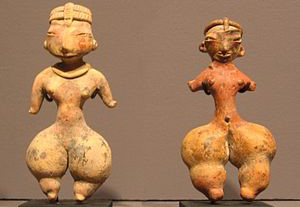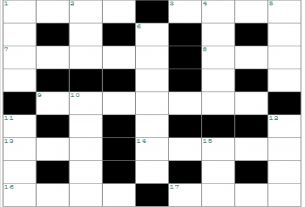By Kirby Vickery on the August 2019 Edition
I found, according to one internet site, there are thirteen different kinds of snakes in Mexico. Then I went to another and found three more. After that, I found some additional varieties. But, I’m not really sure how many varieties there are altogether. Of the seventeen I was able to catalog, they are: The Blunt-Headed Tree Snake, Boa, Brown Vine Sake, Eyelash Palm Pit Vi-per, File Tail Snake, Garter Snake, Guatemalan Pit Viper, Jumping Pit Viper, Mexican Cantil Viper, Mexican Green Rat Snake, Mexican King Snake, Mexican Milk Snake, Mexican Westcoast Rattle Snake, and the Neotropical Rattle Snake. One is protect-ed by the government, and some are harmless, while others live in the trees, not wanting to see, meet up with, or prey on anything larger than a bird. They are inherently shy and have a tendency to shun human contact so, if you run across one, just leave it alone and back away so you and your not-a-pet snake can each go separate ways.
The snakes that are introduced and written about by the Mesoamerican societies were not real ones. Snakes had a special place in the mythical worlds of the Aztec, Maya, Olmec and other empires. Aztec and Maya mythology describes serpents as being the vehicles by which celestial bodies, such as the sun and stars, cross the heavens. The shedding of their skin made them a symbol of rebirth and renewal. Although shunned for its shape and mobility methods, the Mixtec peoples regarded the snake as a symbol of rebirth, shrewdness, patience, intellect, fertility, longevity, vigilance, eternity, protection, rejuvenation, intuition, enigma, and splendor.
One of the oldest major civilizations, The Olmec, were a shamanistic people and Jaguars were the shamans of the animal world. Their chief god was a ‘Nahual.’ It was depicted as being half-human and half-Jaguar. Then they had a ‘Were jaguar’ which was the result of a jaguar mating with a human. They did have a “Plumed Serpent” which was seventh god in line of importance. It’s very confusing because no one can read their language yet. Most everything about them, including their religious beliefs, will remain unknown until archeologists can figure out their written language.
The Mayan people kicked the serpent from 7th to 1st place in the order of importance, put some feathers on him, named him Kukulcan and made him their chief god, then built a pyramids and entire cities in his honor.
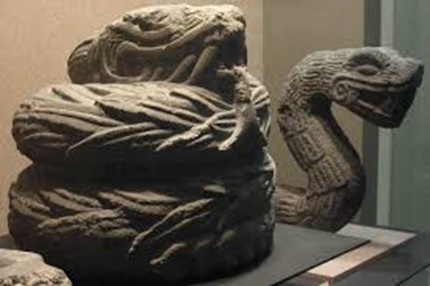
We know, through the translated Popol Vuh (The Maya “Bible”), that they knew of the nine underlying waves in the quantum field that drives the evolution of the universe and all things it contains. This wave form came from the Plumed Serpent who, to them, was a living deity. The calendar they developed plot-ted its movements and, from this plot, they could determine the rise and fall of civilization. As such, it became an important tool to chart the destiny of their civilization. It’s a shame that the Aztecs picked up on its use as a calendar but didn’t know about, or ignored, the section that contained the “Long Count” which accurately foretold of the arrival of the Spanish.
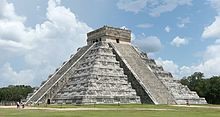
This structure is unique because it showed the ‘waves’ of the serpent going up and down on both equinoxes
The coiled snake headdress is a significant artifact worn by Mayan women, both ancient and modern. There are carved stone monuments, drawings in screen-fold paper books (codices), painted ceramic pots and on murals of women wearing this particular headdress. They are worn today by women who practice midwifery in the tradition of the goddess Ix Chel. In modern times, each village has its own curendera, who practices the ancient art of Mayan medicine.
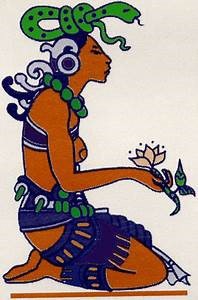
The Aztecs took the Winged Serpent that they named Quetzal coatl and made him the Creator God, subject to receiving many human sacrifices as tribute.
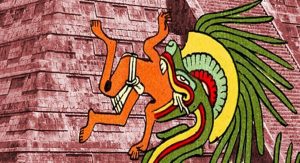
Quetzalcoatl was one of four sons to To nacatehuctli and To nacacihuatl who were the original creator gods according to Aztec mythology. He, along with one of his brothers, was told to create the world according to the Mendoza Codex. As it turned out, this really wasn’t a good idea because of the animosity that existed between the two. As a matter of fact, Quetzalcoatl tried to kill Tezcatlipoca, during the creation of the 1st Age, with a stone club. This is why his brother commanded all the jaguars to eat up all the people. This happened four additional times where one would attempt to get even with the other. We are the living result in the 5th Age.
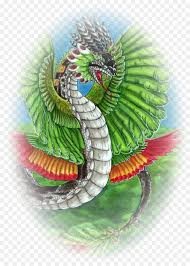
Another way this story unfolds was with the brothers cooperating and actually getting to create the earth and the sky. They had to transform themselves into two immense giant serpents, complete with feathers, to attack a female monster that was also reptilian, named Tlaltcuhtli (Cipactli) and tore her in half in the process. Then they went on to create other things like the moon, stars, the sun, other lesser gods as well as the first man and woman.
There is a Toltec myth that tells how Quetzalcoatl actually came to an end. The brother of Quetzalcoatl, Tezcatlipoca, wanted to get rid of him for once and for all. One evening, he was able to get Quetzalcoatl really drunk, which ended up with him sleeping with his sister, Quetzalpétatl, committing incest. When he woke up and saw what he had done he built a large pyre and sacrificed himself in it. Another version has him wandering down to the Gulf and sailing away on a raft he made of snakes. In the burning version, he later emerges as the planet Venus. You pick.
The full edition or view it online
—
Kirby was born in a little burg just south of El Paso, Texas called Fabens. As he understand it, they we were passing through. His history reads like a road atlas. By the time he started school, he had lived in five places in two states. By the time he started high school, that list went to five states, four countries on three continents. Then he joined the Air Force after high school and one year of college and spent 23 years stationed in eleven or twelve places and traveled all over the place doing administrative, security, and electronic things. His final stay was being in charge of Air Force Recruiting in San Diego, Imperial, and Yuma counties. Upon retirement he went back to New England as a Quality Assurance Manager in electronics manufacturing before he was moved to Production Manager for the company’s Mexico operations. He moved to the Phoenix area and finally got his education and ended up teaching. He parted with the university and moved to Whidbey Island, Washington where he was introduced to Manzanillo, Mexico. It was there that he started to publish his monthly article for the Manzanillo Sun. He currently reside in Coupeville, WA, Edmonton, AB, and Manzanillo, Colima, Mexico, depending on whose having what medical problems and the time of year. His time is spent dieting, writing his second book, various articles and short stories, and sightseeing Canada, although that seems to be limited in the winter up there.


